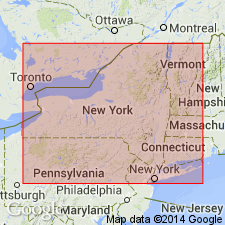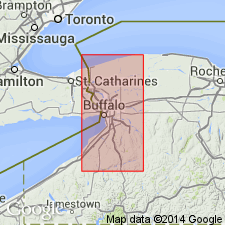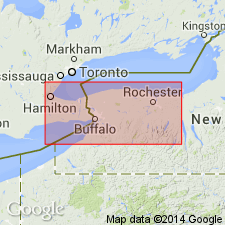
- Usage in publication:
-
- Vinemount Member
- Modifications:
-
- Areal extent
- Dominant lithology:
-
- Shale
- Clay
- AAPG geologic province:
-
- Appalachian basin
Summary:
Beds overlying the Niagara Falls Member of the Goat Island Formation are assigned presently to the Ancaster and Vinemount Members of the Goat Island Formation. Both of these units have their type sections near Hamilton, Ontario. The Vinemount overlies the Ancaster Member and consists of a basal layer of dark gray dolomitic shale and a 3 m-thick bituminous argillaceous unit. It has been traced to its type locality in Ontario. These argillaceous beds appear to grade laterally and vertically into Ancaster cherty dolostone beds and therefore both are assigned member status in the Goat Island. Fossils are rare in the Vinemount and poorly preserved, but include rhynchonellid and atrypid brachiopods, small rugose and favositid corals and large nautiloid DAWSONOCERAS. Age of the Goat Island and its members is Middle Silurian.
Source: GNU records (USGS DDS-6; Reston GNULEX).

- Usage in publication:
-
- Vinemount Member
- Modifications:
-
- Overview
- AAPG geologic province:
-
- Appalachian basin
Summary:
Lockport Group in this report is considered Late Silurian following Rickard (1975) as the NY Geological Survey does not recognize Middle Silurian as does the USGS. The revisions to the Lockport nomenclature discussed in this report will be formally proposed by C.E. Brett in a larger study of the Niagaran Series. The Lockport Group is divided into the (ascending) Gasport Limestone, the Goat Island Dolomite, the Eramosa Dolomite, and the Guelph Dolomite. The Gasport includes the Gothic Hill and Pekin Members, and the Goat Island includes the Niagara Falls, Ancaster, and Vinemount Members. [Though three of the authors of this report (Tepper, Kappel, and Yager) are USGS scientists, the nomenclature used here has not been officially accepted for use by the USGS.]
Source: GNU records (USGS DDS-6; Reston GNULEX).

- Usage in publication:
-
- Vinemount Member*
- Modifications:
-
- Revised
- Dominant lithology:
-
- Dolomite
- Shale
- Chert
- AAPG geologic province:
-
- Appalachian basin
Summary:
The Vinemount Member of the Goat Island Dolomite, named for Vinemount, Saltfleet Township, Ontario, CAN, is formalized in this report. Unit has been previously referred to as Vinemount shale beds (Hewitt, 1960). Consists of light- to dark-gray, medium- to thin-bedded, very fine-grained, argillaceous dolomite with thin shale partings. Unit is commonly bituminous and bluish-gray chert is found in the upper 5 feet. Thickness is 17 to 20 ft. Conformably overlies the Ancaster Member of the Goat Island Dolomite and conformably underlies the Eramosa Dolomite. West of Hamilton, Ontario, CAN, unit grades laterally into massive carbonates of the Amabel Formation. The Vinemount is of Late Silurian (Ludlovian) age. [Report uses Silurian time scale of Harland and others (1982).]
Source: GNU records (USGS DDS-6; Reston GNULEX).
For more information, please contact Nancy Stamm, Geologic Names Committee Secretary.
Asterisk (*) indicates published by U.S. Geological Survey authors.
"No current usage" (†) implies that a name has been abandoned or has fallen into disuse. Former usage and, if known, replacement name given in parentheses ( ).
Slash (/) indicates name conflicts with nomenclatural guidelines (CSN, 1933; ACSN, 1961, 1970; NACSN, 1983, 2005, 2021). May be explained within brackets ([ ]).

